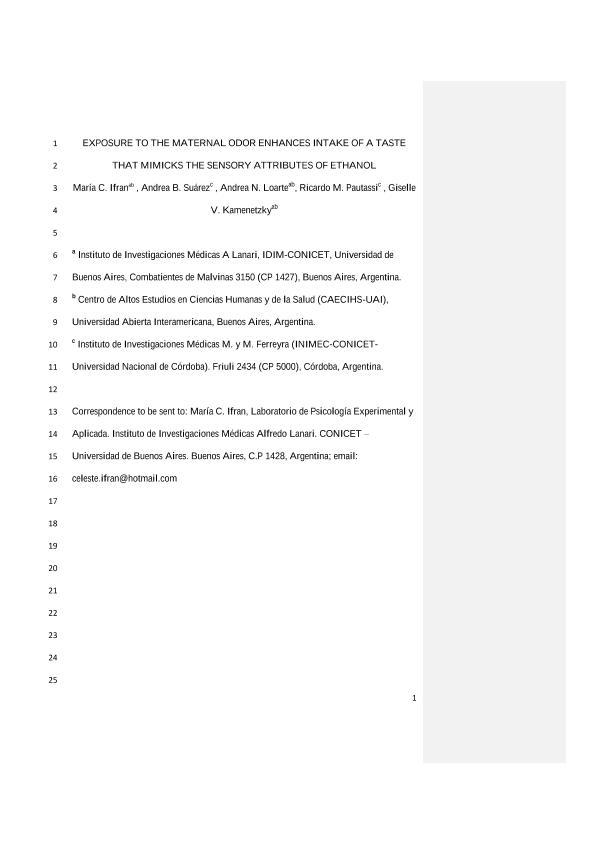Artículo
Exposure to maternal odor enhances intake of a taste that mimicks the sensory attributes of ethanol
Ifrán, María Celeste ; Suarez, Andrea Beatriz
; Suarez, Andrea Beatriz ; Loarte Velasquez, Andrea Nataly; Pautassi, Ricardo Marcos
; Loarte Velasquez, Andrea Nataly; Pautassi, Ricardo Marcos ; Kamenetzky, Giselle Vanesa
; Kamenetzky, Giselle Vanesa
 ; Suarez, Andrea Beatriz
; Suarez, Andrea Beatriz ; Loarte Velasquez, Andrea Nataly; Pautassi, Ricardo Marcos
; Loarte Velasquez, Andrea Nataly; Pautassi, Ricardo Marcos ; Kamenetzky, Giselle Vanesa
; Kamenetzky, Giselle Vanesa
Fecha de publicación:
01/2019
Editorial:
Psychonomic Society
Revista:
Learning & Behavior
ISSN:
1543-4494
e-ISSN:
1543-4508
Idioma:
Inglés
Tipo de recurso:
Artículo publicado
Clasificación temática:
Resumen
Early exposure to ethanol increases subsequent acceptance of this drug. Little attention, however, has been devoted to the interaction of the taste of the drug with other, familiar or non-familiar, odors contingent with ethanol access, particularly early in ontogeny. This study assessed the influence of exposure to maternal odor on intake and grasp responses to an artificial nipple providing a solution (a sucrose-quinine mix) that emulates the taste of alcohol, in 4-day-old rat pups. The results showed that the mother’s odor enhanced intake from and seeking responses to an artificial nipple that provided the solution that mimicked the taste of alcohol (Experiment 1). This pattern of results was not evoked by the odor of an unrelated dam (Experiment 2), nor was it observed when the nipple delivered water. The main new finding of the present study is that 4-day-old rats tested in the presence of the mother (and hence exposed to her odor cues) exhibited enhanced seeking and intake of a solution that mimics the chemosensory properties of ethanol.
Palabras clave:
ODOR
,
ONTOGENY
,
RATS
,
TASTE
Archivos asociados
Licencia
Identificadores
Colecciones
Articulos(INIMEC - CONICET)
Articulos de INSTITUTO DE INV. MEDICAS MERCEDES Y MARTIN FERREYRA
Articulos de INSTITUTO DE INV. MEDICAS MERCEDES Y MARTIN FERREYRA
Citación
Ifrán, María Celeste; Suarez, Andrea Beatriz; Loarte Velasquez, Andrea Nataly; Pautassi, Ricardo Marcos; Kamenetzky, Giselle Vanesa; Exposure to maternal odor enhances intake of a taste that mimicks the sensory attributes of ethanol; Psychonomic Society; Learning & Behavior; 47; 4; 1-2019; 302-309
Compartir
Altmétricas



